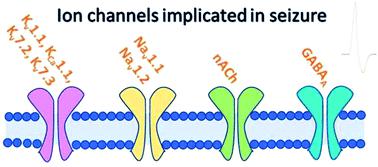当前位置:
X-MOL 学术
›
Toxicol. Res.
›
论文详情
Our official English website, www.x-mol.net, welcomes your
feedback! (Note: you will need to create a separate account there.)
Innovative models for in vitro detection of seizure.
Toxicology Research ( IF 2.2 ) Pub Date : 2019-10-24 , DOI: 10.1039/c9tx00210c Kimberly L Rockley 1 , Ruth A Roberts 1, 2 , Michael J Morton 1
Toxicology Research ( IF 2.2 ) Pub Date : 2019-10-24 , DOI: 10.1039/c9tx00210c Kimberly L Rockley 1 , Ruth A Roberts 1, 2 , Michael J Morton 1
Affiliation

|
Data show that toxicity to the central nervous system (CNS) is the most frequent cause of safety failures during the clinical phase of drug development. CNS endpoints such as seizure pose a safety risk to patients and volunteers and can lead to a loss of competitiveness, delays, and increased costs. Current methods rely on detection in the nonclinical rodent and non-rodent studies required to support clinical trials. There are two main issues with this approach; seizure may be missed in the animal studies and, even if seizure is detected, significant resource has already been invested in the project by this stage. Thus, there is a need to develop improved screening methods that can be used earlier in drug discovery to predict seizure. Advances in stem cell biology coupled with an increased understanding of the role of ion channels in seizure offer an opportunity for a new paradigm in screening. Human derived induced pluripotent stem cells (hiPSCs) representative of almost all cellular subtypes present in the brain can be incorporated into physiologically relevant in vitro models that can be used to determine seizure risk using high-throughput methods. Akin to the success of screening against a panel of ion channels such as hERG to reduce cardiovascular safety liability, the involvement of ion channels in seizure suggests that a similar approach to early seizure detection is valid. Profiling of the ion channels expressed in hiPSC models showing the seizurogenic phenotype coupled with electrophysiological assessment of ion channel function could translate into an ion channel seizure panel for rapid and reliable in vitro detection of seizure. The mechanistic information gathered would support optimal drug design early in development before resources, animals and time have been wasted.
中文翻译:

体外检测癫痫发作的创新模型。
数据显示,在药物开发的临床阶段,对中枢神经系统(CNS)的毒性作用是导致安全性失败的最常见原因。中枢神经系统端点(例如癫痫发作)对患者和志愿者造成安全风险,并可能导致竞争力下降,延误和成本增加。当前的方法依赖于支持临床试验所需的非临床啮齿动物和非啮齿动物研究中的检测。这种方法有两个主要问题:动物研究中可能没有发现癫痫发作,即使已经发现癫痫发作,在此阶段也已经在该项目上投入了大量资源。因此,需要开发改进的筛选方法,其可以在药物发现中更早地用于预测癫痫发作。干细胞生物学的进步,加上对离子通道在癫痫发作中作用的认识的加深,为筛选新范式提供了机会。可以将代表脑中存在的几乎所有细胞亚型的人源诱导多能干细胞(hiPSC)整合到生理相关的体外模型中,该模型可用于通过高通量方法确定癫痫发作的风险。类似于针对一系列离子通道(如hERG)进行筛选以降低心血管安全性的成功措施一样,离子通道参与癫痫发作表明早期癫痫发作检测的类似方法是有效的。在hiPSC模型中表达的离子通道分析显示了致精神病性表型,加上离子通道功能的电生理评估,可以转化为离子通道癫痫发作面板,用于快速,可靠的体外癫痫发作检测。所收集的机械信息将在资源,动物和时间被浪费之前,在开发的早期支持最佳的药物设计。
更新日期:2019-10-24
中文翻译:

体外检测癫痫发作的创新模型。
数据显示,在药物开发的临床阶段,对中枢神经系统(CNS)的毒性作用是导致安全性失败的最常见原因。中枢神经系统端点(例如癫痫发作)对患者和志愿者造成安全风险,并可能导致竞争力下降,延误和成本增加。当前的方法依赖于支持临床试验所需的非临床啮齿动物和非啮齿动物研究中的检测。这种方法有两个主要问题:动物研究中可能没有发现癫痫发作,即使已经发现癫痫发作,在此阶段也已经在该项目上投入了大量资源。因此,需要开发改进的筛选方法,其可以在药物发现中更早地用于预测癫痫发作。干细胞生物学的进步,加上对离子通道在癫痫发作中作用的认识的加深,为筛选新范式提供了机会。可以将代表脑中存在的几乎所有细胞亚型的人源诱导多能干细胞(hiPSC)整合到生理相关的体外模型中,该模型可用于通过高通量方法确定癫痫发作的风险。类似于针对一系列离子通道(如hERG)进行筛选以降低心血管安全性的成功措施一样,离子通道参与癫痫发作表明早期癫痫发作检测的类似方法是有效的。在hiPSC模型中表达的离子通道分析显示了致精神病性表型,加上离子通道功能的电生理评估,可以转化为离子通道癫痫发作面板,用于快速,可靠的体外癫痫发作检测。所收集的机械信息将在资源,动物和时间被浪费之前,在开发的早期支持最佳的药物设计。











































 京公网安备 11010802027423号
京公网安备 11010802027423号